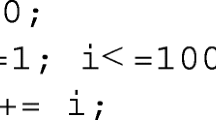Abstract
This paper presents a cognitive framework for describing behaviors involved in program composition, comprehension, debugging, modification, and the acquisition of new programming concepts, skills, and knowledge. An information processing model is presented which includes a long-term store of semantic and syntactic knowledge, and a working memory in which problem solutions are constructed. New experimental evidence is presented to support the model of syntactic/semantic interaction.
Similar content being viewed by others
References
J. D. Aron,The Program Development Process: Part 1, The Individual Programmer (Addison-Wesley, Reading, Massachusetts, 1974).
D. P. Ausubel,Educational Psychology: A Cognitive Approach (Holt, Rinehart and Winston, New York, 1968).
J. Bransford and J. Franks, “Abstraction of linguistic ideas,”Cognit. Psychol. 2:331–350 (1971).
Frederick Brooks, Jr.,The Mythical Man-Month: Essays on Software Engineering (Addison-Wesley, Reading, Massachusetts, 1975).
W. A. Brownell, “Psychological Considerations in the Learning and Teaching of Arithmetic,” inThe Teaching of Arithmetic: Tenth Yearbook of the National Council of Teachers of Mathematics, Bureau of Publications, Teachers College, Columbia University, New York (1935), pp. 1–35.
O.-J. Dahl, E. W. Dijkstra, and C. A. R. Hoare,Structured Programming (Academic Press, London-New York, 1973).
K. Duncker, “On problem solving,”Psychol. Monogr. 58:270 (1945).
E. A. Feigenbaum, “Information Processing and Memory,” inModels of Memory, D. A. Norman, Ed. (Academic Press, New York, 1970), pp. 451–469.
J. D. Gannon and J. J. Horning, “The Impact of Language Design on the Production of Reliable Software,”IEEE Trans. on Software Engineering,1 (1975).
J. G. Greeno, “The Structure of Memory and the Process of Problem Solving,” inContemporary Issues in Cognitive Psychology, R. Solso, (Winston, Washington, 1973).
G. Katona,Organizing and Memorizing (Columbia University Press, New York, 1940).
C. Kreitzberg and L. Swanson, “A Cognitive Model for Structuring an Introductory Programming Curriculum,”AFIPS Proceedings of the National Computer Conference (AFIPS Press, Montvale, New Jersey, 1974).
N. R. F. Maier, “Reasoning in humans, I, On direction,”J. Comp. Psychol. 12:115–143 (1930).
R. E. Mayer, “Different problem-solving competencies established in learning computer programming with and without a meaningful model,”J. Educ. Psychol. 68:143–150 (1976).
G. A. Miller, “The magical number seven, plus or minus two: Some limits on our capacity for processing information,”Psychol. Rev. 63:81–97 (1956).
L. Miller, “Programming by Non-Programmers,” IBM Research Report RC4280 (1973).
D. L. Parnas, “On the criteria to be used in decomposing systems into modules,”Commun. ACM 15:1053–1058 (December 1972).
G. Polya,How to Solve It (Doubleday, New York, 1957).
P. Reisner, R. F. Boyce, and D. D. Chamberlin, “Human Factors Evaluation of Two Data Base Query Languages: SQUARE and SEQUEL,”Proceedings of the National Computer Conference (AFIPS Press, Montvale, New Jersey, 1975).
J. Sachs, “Recognition memory for syntactic and semantic aspects of connected discourse,”Percept. Psychophys. 2:437–442 (1967).
B. Shneiderman, “Experimental Testing in Programming Languages, Stylistic Considerations and Design Techniques,”Proceedings of the National Computer Conference (AFIPS Press, Montvale, New Jersey, 1975).
B. Shneiderman, “A review of design techniques for programs and data,”Software-Pract. Exper. 6:555–567 (1976).
B. Shneiderman, “Exploratory experiments in programmer behavior,”Int. J. Comput. Inf. Sci. 5(2):123–143 (June 1976).
B. Shneiderman, R. Mayer, D. McKay, and P. Heller, “Experimental investigations of the utility of detailed flowcharts in programming,”Commun. ACM 20:373–381 (1977).
B. Shneiderman, “Measuring computer program quality and comprehension,”Int. J. Man-Mach. Stud. 9:465–478 (1977).
B. Shneiderman, “Teaching programming: A spiral approach to syntax and semantics,”Comput. Educ. 1:193–197 (1977).
M. Sime, T. Green, and D. Guest, “Psychological evaluation of two conditional constructions used in computer languages,”Int. J. Man-Mach. Stud. 5:105–113 (1973).
J. C. Thomas and J. D. Gould, “A Psychological Study of Query by Example,”Proceedings of the 1975 National Computer Conference (AFIPS Press, Montvale, New Jersey, 1975).
G. M. Weinberg,The Psychology of Computer Programming (Van Nostrand-Reinhold, New York, 1971).
L. Weissman, “Psychological Complexity of Computer Programs: An Initial Experiment,” Technical Report CSRG-26, Computer Systems Research Group, University of Toronto, Toronto, Canada (1973).
L. Weissman, “Psychological complexity of computer programs: An experimental methodology,SIGPLAN Not. 9:25–36 (June 1974).
M. Wertheimer,Productive Thinking (Harper & Row, New York, 1959).
W. Wickelgren,How to Solve Problems (W. H. Freeman, San Francisco, 1974).
Niklaus Wirth, “Program development by stepwise refinement,”Commun. ACM 14:4 (April 1971).
E. A. Youngs, “Human errors in programming,”Int. J. Man-Mach. Stud. 6:361–376 (1974).
H. Mills, “Top Down Programming in Large Systems,” in R. Rustin (Ed.),Debugging Techniques in Large Systems (Prentice-Hall, Englewood Cliffs, N. J., 1971).
D. McCracken,A Simplified Guide to FORTRAN IV Programming, (John Wiley and Sons, New York, 1974).
Author information
Authors and Affiliations
Rights and permissions
About this article
Cite this article
Shneiderman, B., Mayer, R. Syntactic/semantic interactions in programmer behavior: A model and experimental results. International Journal of Computer and Information Sciences 8, 219–238 (1979). https://doi.org/10.1007/BF00977789
Received:
Revised:
Issue Date:
DOI: https://doi.org/10.1007/BF00977789




